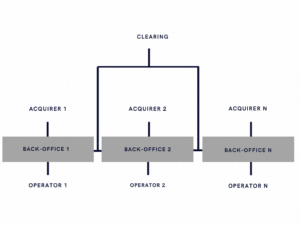The purpose of this article is to summarise key considerations to enabling a MaaS solution (which, in the opinion of the author, can also be thought of as an integrated ticketing and settlement scheme).
How is a MaaS solution defined?
MaaS (Mobility as a Service) has been defined as a joint digital channel enabling patrons to plan, book, and pay for multiple types of mobility services (these services may be supplied by either government agencies or private operators).
How is a MaaS solution created?
Assuming the mobility services exist and will appeal to the patron when combined, there must generally be a shared desire for agencies or operators to inter-operate (in this case to be part of the MaaS solution and to through-ticket). To enable such interoperability and cooperation, all parties need a business case or mandate, which may not be wholly financial (it could be political or related to social impact). The solution must enable interoperability through technology and integrated ticketing or transportation-related products / services , the ease of use and pricing of which must offer a benefit to the patrons of the new channel (some examples could be via a subscription product, combining multiple fares into some form of through-ticket or a post-processed discount or cap on PAYG). Only when this joint desire to inter-operate has been established, along with an associated business case or mandate and an intent to enable this through shared technology – is there actually a joint objective to form a basis of an offering.
What are likely to be the barriers to setting up a MaaS solution?
- Lack of business case or mandate for the players involved
- The unwillingness of patrons to adopt solutions (Lack of appeal, gaps in solutions, limited technology adoption, happy with their current application or mode)
- Lack of standardisation (data, technology, rules of engagement)
- Lack of governance between players (organisation)
- Competing and misaligned goals of parties involved (commercial, political, policy)
From the agency or operator perspective, how might they create a MaaS solution?
- Create a justified business case and / or mandate for all parties including the patron
- Implement the following:
- Shared standards (e.g. for data description, data exchange, scheme rules)
- Shared algorithms, timetabling, usage data (for journey planning, settlement transport planning and audit)
- Shared integrated technology for customer use
- Shared integrated technology to enable automation of payments between operators
- Shared governance to organise and manage the solution on an ongoing basis
Conclusion
To progress beyond multi-modal journey planners, small scale trials and bi-lateral commercial agreements, a multi-lateral MaaS solution requires a justified business case for each player and must be appealing to the patron. In the absence of a clear business case and a willingness to collaborate to offer an integrated technical solution, an alternative is to align players over time through some form of regulation or mandate to help enable the remainder of the practical gaps above to be resolved. Transport agency or industry body leadership to lead or bind the solution together is likely to be fundamental. This all assumes the transport operations exist in the first place, of course.
It should be noted that the combination of transport operation and technology between agencies and operators for mutual benefit is certainly not a new phenomenon. Its origins in part can be traced back to the Railway Clearing House of 1842. However, the context, players, technology, solutions, business imperatives and buyer / supplier power have changed over time. MaaS as defined above now requires a rethink or perhaps a reinvention of the solutions and governance.


